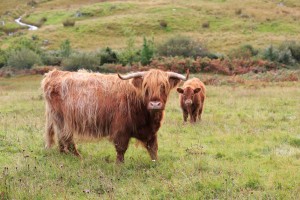Health Benefits of Highland Beef
This hardy and vigorous breed’s long hair coat replaces the thick layer of fat found on most other breeds. The double hair coat allows the animal to marble naturally on low input forage while producing lean, low fat, high quality cuts of beef.
Highland Beef is lower in fat than Snapper (with skin), Pork Loin, Chicken (avg. with skin), Halibut (with skin), and Commercial Beef.
Highland Beef is lower in Cholesterol than Buffalo, Codfish, Venison, Chicken, and Lean Red Beef.
Grass-fed vs. Grain-fed
When you add up the score card between grass-fed and grain-fed beef, grass-fed beef wins hands down. The more naturally raised meat has:
- Less overall fat
- Fewer calories
- More omega-3 fatty acids
- A healthier ratio of omega-6 to omega-3 fatty acids
- More CLA (a newly discovered good fat called conjugated linoleic acid that may be a potent cancer fighter)
- More vitamin E
- More beta-carotene
Like all beef, grass-fed / finished beef is an excellent source of high-quality protein, iron, zinc, selenium, phosphorous, and the B-complex vitamins. But it is superior to grain-fed beef in a number of key ways. It is lower in fat and calories and higher in omega-3 fatty acids and CLA.
Fresh pasture offers hundreds of times more of these nutrients than a standard feedlot diet. As a result, grass-fed meat has up to four times more beta-carotene than conventional feedlot meat. Given all these benefits, a steak from a cow raised on pasture is even healthier for you than a chicken breast – the meat that health authorities are so quick to recommend. The steak has about the same amount of total fat, making it an equally good choice for a heart-healthy diet, but it has more omega-3s. What’s more it has less cholesterol than chicken and more than four times more CLA. Move over chicken. Make room for grass-fed beef!*
*Excerpts from the book “Pasture Perfect: The Far-Reaching Benefits of Choosing Meat, Eggs, and Dairy Products from Grass-Fed Animals” by Jo Robinson.






 Flathead Farms is a proud member of the American Highland Cattle Association’s Quality Highland Beef (QHB) program and subscribes to its guidelines.
Flathead Farms is a proud member of the American Highland Cattle Association’s Quality Highland Beef (QHB) program and subscribes to its guidelines.
 Flathead Farms Grassfed Registered Highland Beef is Montana-bred and Montana-raised on natural pasture in Kalispell, Montana, USA.
Flathead Farms Grassfed Registered Highland Beef is Montana-bred and Montana-raised on natural pasture in Kalispell, Montana, USA.